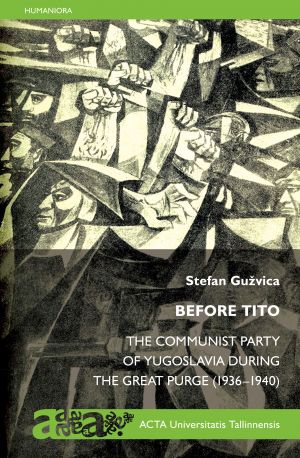Nõukogude Liidu suure terrori ajastu on üks vastuolulisemaid ja vähe uuritud perioode Jugoslaavia Kommunistliku Partei (JKP) ajaloos. Seda on ümbritsenud saladuseloor, sest enamik partei sõdadevahelise perioodi juhtfiguure hukati. Selle ajastu lõpus, 1939. aastal sai partei peasekretäriks Josip Broz Tito, kes püsis sellel ametipostil oma surmani 1980. aastal. Kasutades värskelt avalikustatud Moskva arhiivimaterjale, pakub Stefan Guzhvica esimese süstemaatilise akadeemilise analüüsi sellest otsustavast perioodist JKP ajaloos. Ta kirjeldab detailselt Tito eelkäija Milan Gorkici võimukaotust ning tema terrori käigus kõrvaldatud kolleegide ja rivaalide Ivan Grzhetici, Vladimir Copici ja Stjepan Cvijici allakäiku. Selle asemel et keskenduda ainult Titole, näitab Guzhvica, et Komintern kaalus Jugoslaavia parteile mitut juhikandidaati, nende seal Kamilo Horvatin, Ivo Maric ja Petko Miletic, enne kui 1939. aasta algul Tito kasuks otsustati. Guzhvica selgitab Tito edu tagamaid, uurib tema rivaalide poliitikat ja läbikukkumisi ning pöörab erilist tähelepanu Tito ametissemääramise pikaaegsetele tagajärgedele, mis kulmineerusid 1948. aastal Nõukogude Liidu ja Jugoslaavia suhete katkemisega.
The time of the Great Purge in the Soviet Union has been one of the most controversial and under-researched periods in the history of the Communist Party of Yugoslavia (KPJ). Secrecy has surrounded it because of the executions of most leading members of the party from the interwar era, while its appeal lies in the fact that, at the end of this period in 1939, Josip Broz Tito became the party general secretary, a post he would hold until his death in 1980. Using newly-available archival sources from Moscow, Stefan Guzhvica offers the first academic and systematic analysis of this crucial formative period in the history of the KPJ. He presents, in great detail, the downfall of Milan Gorkic, who led the party before Tito, as well as his closest colleagues and rivals, most of whom were swept away in the Purge, such as Ivan Grzhetic, Vladimir Copic, and Stjepan Cvijic. Rather than focusing on Tito alone, Guzhvica shows that the Comintern considered a wide array of candidates from the Yugoslav party, including Kamilo Horvatin, Ivo Maric, and Petko Miletic, before settling for Tito in early 1939. Guzhvica explains the reasons of Tito's success, examines the policies and failures of his rivals, and pays particular attention to the long-term consequences of Tito's appointment, culminating in the Soviet-Yugoslav split of 1948.













